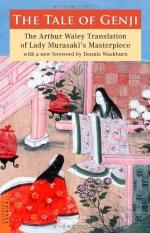|
This section contains 427 words (approx. 2 pages at 400 words per page) |

|
The Tale of Genji Summary & Study Guide Description
The Tale of Genji Summary & Study Guide includes comprehensive information and analysis to help you understand the book. This study guide contains the following sections:
This detailed literature summary also contains Bibliography and a Free Quiz on The Tale of Genji by Murasaki Shikibu.
Murasaki Shikibu's epic-length novel, The Tale of Genji, probes the psychological, romantic and political workings of mid-Heian Japan. The novel earned Murasaki Shikibu notoriety even in the early 11th century, some six hundred years before the printing press made it available to the masses. Court society, which served as the subject of the novel, sought out chapters. Ladies-in-waiting and courtiers even pilfered unrevised copies, according to legend. Some thousand years later, Murasaki Shikibu and her novel continue to delight an enthusiastic audience. Stamps, scrolls, comic books, museums, shower gel, movies, parades, puppet plays, CD-ROMS: Murasaki Shikibu and her creation Genji have achieved National Treasure status in Japan and admiration all over the world.
The tale spreads across four generations, splashed with poetry and romance and heightened awareness to the fleeting quality of life. Murasaki Shikibu's tale of love, sex, and politics explores a complex web of human and spiritual relationships. This focus on characters and their emotional experience, as compared to plot, makes the novel easily accessible to the modern reader. It explains, in part, why many scholars consider Genji to be the world's first great novel.
Readers through the ages have especially admired Murasaki Shikibu's depiction of the Heian court society's deep aesthetic sense. Beautyin flesh, flowers, sunsets, musical notesmoved and influenced the society. The title character, Genji, flourishes in this atmosphere. He is a master of speech, poetry, music, manners, dress.
Many Japanese scholars cite as an influence Chinese poet Po-Ch-I's classic narrative poem, The Song of Unending Sorrow. Murasaki Shikibu writes in her diary of reading the poet's work to the empress. She also refers to it several times in The Tale of Genji. Importantly, the novel also marked Japan's liberation from Chinese influence. According to Richard Bowring in Landmarks of World Literature: The Tale of Genji, "Japan had just emerged from a time of substantial Chinese influ-ence and was going through one of its periodic stages of readjustment, during which alien concepts were successfully naturalized. The Genji is thus the product of a native culture finding a truly sophisticated form of self-expression in prose for the first time."
The Tale of Genji has had a pervasive influence on later Japanese and world-wide art. It has inspired Noh theater, waka poetry, scroll paintings, pop music and dances. It has had an especially profound influence on Japanese literature. Court fiction for hundreds of years after openly modeled itself after Genji. Present-day writers, including Kawabata Yasunari in his 1968 Nobel Prize acceptance speech, still cite The Tale of Genji as a great influence.
Read more from the Study Guide
|
This section contains 427 words (approx. 2 pages at 400 words per page) |

|



